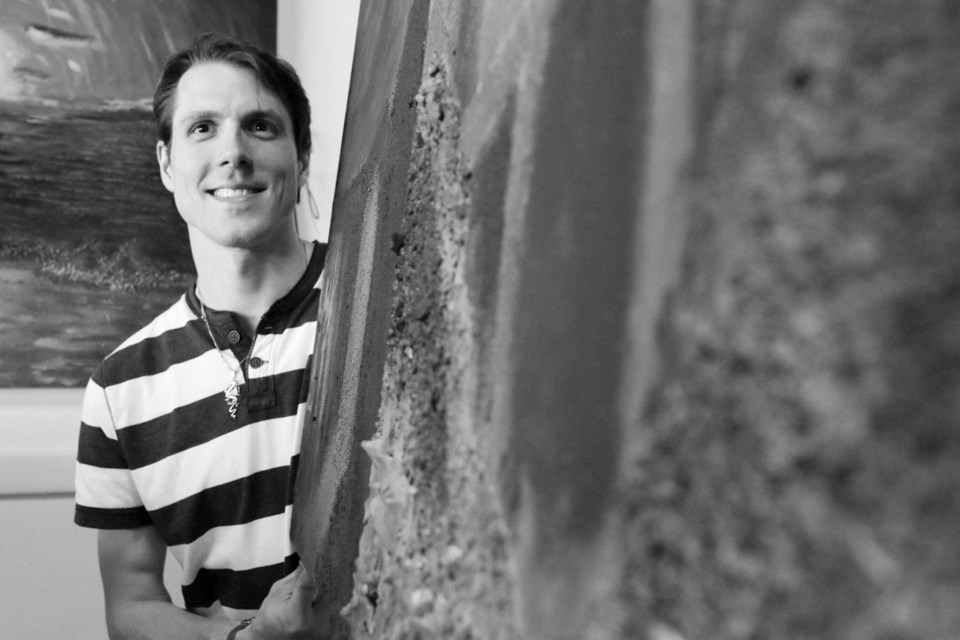╠²
╠²
When a car struck Richard Harlow, it was a hard nudge to let the Nanaimo artist know it was time to carry a white cane.
ŌĆ£It was kind of a wakeup call that I need to learn how to adjust,ŌĆØ said Harlow, 28, who was losing his vision.
ŌĆ£So, I learned how traffic lights had different beeping sounds and I learned how to really listen for traffic. And I just started to pay more attention to auditory things instead of trying to carry on with my failing vision.ŌĆØ
Harlow, now enrolled at Vancouver Island University, studying psychology and art, began to lose his vision in 2009. It was a rare disease known as Leber hereditary optic neuropathy that left him with only limited, peripheral vision.
The white cane is not the only adjustment for Harlow in dealing with vision loss.
He has also studied Brazilian jiu jitsu to cope with the bullies and muggers the white cane seems to attract. As an artist, he has learned new techniques of mixing paint and applying it. And he has become an outspoken advocate for people with disabilities.
ŌĆ£There are just so many things that people with disabilities deal with every day that can be so infuriating,ŌĆØ Harlow said. ŌĆ£So I want to get into community politics and start advocating for people with disabilities.ŌĆØ
When the blindness first started to manifest, Harlow was studying 3D animation at Emily Carr University of Art and Design in Vancouver. It took only about six months before he was legally blind. He returned to Nanaimo, where he had first studied art at VIU.
Initially, Harlow remembers, his vision loss triggered a terrible depression. His entire life had been aimed at a career in the visual arts. Once his vision went, just picking up a paintbrush was emotionally devastating.
But he was lucky enough to have first studied painting while serving an apprenticeship with a professional artist. It was almost a classical approach, and Harlow learned basic lessons in mixing colours and composition.
When he returned to painting, he made basic adjustments to his work routines. His limited sight means he must get very close to the canvas ŌĆö frequently so close that he gets paint on his nose and forehead. His girlfriend calls him ŌĆ£Paintface.ŌĆØ
Harlow shifted his style from sharp realism to abstract work that relies more on dynamic colours and contrast than representation. He also started mixing in materials such as crushed walnut shells to give his work texture, and encourages viewers to touch his paintings.
Harlow started to approach painting with accessibility in mind ŌĆö thinking almost like an interior designer arranging a home or office layout for people with disabilities.
ŌĆ£If I want to make art inclusive, how can I do that?ŌĆØ he said. ŌĆ£I try to think of that all the time.ŌĆØ
For example, one of his paintings, of a sunset, is best viewed ŌĆö and touched ŌĆö from a seated position, as if one were in a wheelchair. ItŌĆÖs only looking up, as though from a chair, that you can achieve the full effect of clouds descending and enveloping you. ItŌĆÖs only by reaching out from seated height that you can touch the textures in the groundwork.
Harlow has also had to deal with the physical abuse blindness and the white cane attracts. Often, itŌĆÖs loutish behavior from men who seem to resent seeing him with his cane in a bar, a club or just out at a concert.
ŌĆ£So many people think people with disabilities hate the world,ŌĆØ he said. ŌĆ£ItŌĆÖs not a matter of hating the world; itŌĆÖs a matter of hating how they sometimes get treated in the world.ŌĆØ
After being mugged three times, Harlow enrolled in a martial-arts school to learn Brazilian jiu jitsu. It suited him because itŌĆÖs mostly about grappling and ground-level defence and he can approach it primarily by touch.
After several years of instruction, he can hold his own well enough that fellow athletes often donŌĆÖt realize he is blind.
ŌĆ£A lot of times, we have visitors from other martial-arts schools and they donŌĆÖt even realize IŌĆÖm visually impaired until I walk off the mats and grab my white cane,ŌĆØ Harlow said.
He has learned to be outspoken about the need for the community to adjust to include people with disabilities. But it starts with being open about his own impairment. So Harlow tried his hand at standup comedy.
He first learned he could be funny while being treated in hospital. Nurses were always warning him to stop making other patients laugh so hard because they were shaking loose their intravenous tubes, Harlow said.
He has been asked to be master of ceremonies at burlesque shows, where he even picked up a few gigs as a model. Using his ears, he can pick up the clicks of the camera to know where to direct his eyes.
Weeks ago, Harlow hiked up a mountain and rappelled down a cliff face. He did it with a friend who is completely blind and helped his pal on the way down.
ŌĆ£IŌĆÖm always asking: ŌĆśCan a blind person really do that?ŌĆÖ and in most cases, the answer is ŌĆśYes,ŌĆÖ ŌĆØ he said. ŌĆ£I just try to get out there and prove to myself and everyone else that a visually impaired person is not just some lazy sack of bones.ŌĆØ
